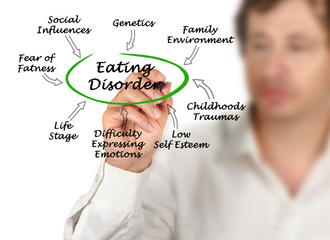Written by: Samantha DeCaro, PsyD
Director of Clinical Outreach & Education at The Renfrew Center
Intergenerational trauma can have a massive impact on whether a person develops an eating disorder. In this post, we look at the connection from every angle, including how families can help break free of the cycle.
 Eating disorders commonly co-occur with various psychiatric diagnoses and certain stressful experiences can elevate our risk of developing one. For example, numerous research studies suggest that a history of trauma, adverse childhood experiences (ACES), post-traumatic stress disorder (PTSD), complex PTSD, and even sub-threshold PTSD are all linked to and associated with disordered eating, eating disorders, and eating disorder severity (Brewerton et al., 2020; Rienecke et al., 2022).
Eating disorders commonly co-occur with various psychiatric diagnoses and certain stressful experiences can elevate our risk of developing one. For example, numerous research studies suggest that a history of trauma, adverse childhood experiences (ACES), post-traumatic stress disorder (PTSD), complex PTSD, and even sub-threshold PTSD are all linked to and associated with disordered eating, eating disorders, and eating disorder severity (Brewerton et al., 2020; Rienecke et al., 2022).
In addition, there is mounting evidence that traumatic and adverse life experiences not only impact the victim on an emotional, cognitive, and biological level, but also seem to get passed down through future generations.
Understanding intergenerational trauma is an important component of eating disorder prevention, treatment, and recovery. The more we understand about the transmission of trauma and its lasting impacts, the better equipped we are to break cycles, support well-being, and reduce eating disorder risk across generations.
How Are Trauma & Eating Disorders Connected?
Trauma related disorders and their symptoms commonly co-occur with an eating disorder diagnosis. There are various theories as to why these experiences frequently travel together. Eating disorders are often conceptualized as emotional disorders, and symptoms such as restricting, bingeing, and purging can serve various functions for someone who has experienced trauma.
Trauma and adverse events can evoke physical, mental, and psychological distress for years to come, including intrusive thoughts, intolerable physical sensations, and intense emotions such as guilt, anxiety, and fear. Eating disorder symptoms can be a way to escape, dampen, or numb these experiences, creating a reinforcing sense of temporary relief or distraction.
Various studies suggest that adverse childhood experiences can potentially impact our bodies on a biological level, disrupting our stress response systems, our immune system, and our hormonal system (Carpenter et al., 2007; Danese, 2012), all of which impacts risk for many eating disorders and their co-occurring mental health diagnoses.
What is Intergenerational Trauma?
When we talk about trauma in the mental health field, we’re often focusing on life-threatening or highly adverse events that someone directly encounters and experiences during their lifetime.
These events can have lasting impacts across various domains, potentially affecting people physically, psychologically, and socially and can result in trauma related diagnoses, such as PTSD, C-PTSD, and sub-threshold PTSD. Intergenerational trauma, however, is a distinct type of trauma that can develop indirectly. It can be transmitted across generations without someone ever being exposed to the trauma or even knowing the trauma ever occurred (McCloughen et al., 2021).
The passing down of trauma
There are various studies that support the notion that trauma can be transmitted. For example, if a parent reports adverse experiences in childhood, the risk of ACE exposure is significantly elevated for their own children. The impact of parental trauma and adverse childhood experience may impact children in various ways throughout their lifespan and even before their birth (Haynes et al., 2020; Mersky et al., 2019).
Intergenerational trauma can also be rooted in historical trauma, collective trauma, and negative community forces such as racism, oppression, weight discrimination, and food insecurity. These experiences are all risk factors for eating disorders and marginalized populations are especially vulnerable physically and psychologically across generations.
How Does Intergenerational Trauma Get Passed Down?
There are various theories explaining how intergenerational trauma might travel through generations. Family systems theories suggest that trauma can be inherited through relational dynamics. A parent, caregiver, or guardian who carries the burden and overwhelming stress of a traumatic event or ACE may also experience mental and emotional challenges that can potentially impact their parenting style and attachment to a child.
Impact on parents
Trauma symptoms can interfere with a parent’s ability to cope with the demands, commitments, and responsibilities within the parenting role, increasing the risk of hostile interactions, aggravation, and harsh forms of discipline; these dynamics can potentially increase the risk of a child having their own ACE or trauma by adulthood (Haynes et al., 2020).
Impact on children
According to social learning theory (Bandura, ,1986), children might also learn how to respond, react, and interact with their environment by observing their caregivers or other adults in their environment. It’s possible a child could learn to fear or avoid something they perceive as dangerous, even without directly being harmed by it.
How genetics & environment interact
According to epigenetic research, external factors play a role in the way our genes are expressed. In other words, it’s not just nature and nurture – it’s the interaction of both. Environmental factors and stressful life experiences can potentially turn certain genes “on” or “off”. It can be helpful to picture your DNA like a set of piano keys – there are many keys, but each key must be pressed down to produce a musical note.
An experiential factor, like a traumatic event, might press on a piano key. Scientists believe that our ancestors’ experiences can press down on our DNA keys before we’re even born, which might explain how trauma trickles down generations and potentially compromises physical and psychological health. For example, researchers discovered that those who were conceived during the famine of the “Dutch Hunger Winter” experienced various long-term effects to their mental health, including vulnerabilities to depression and a heightened stress response (Roseboom et al., 2011).
Furthermore, scientists at Emory University found that mice who were shocked while sniffing a cherry-like scent obviously developed a fear of that scent. Surprisingly, subsequent generations had the same exact fear despite never being shocked. Even the mice who were conceived through in-vitro fertilization (via the sperm of a traumatized mouse) were afraid of the smell (Dias et al., 2014). There’s mounting evidence that we can be impacted by the trauma of our parents – and of our grandparents – without ever directly experiencing or knowing about their trauma.
6 Tips for Breaking the Cycle of Intergenerational Trauma
Our DNA is not destiny. Just as stressful events create vulnerabilities, they can also contribute to generational strengths, resilience, and growth. There are also numerous protective factors we can put in place to protect and promote mental health while reducing our risk to eating disorders and other co-occurring disorders.
Here are 6 ways to protect mental health and reduce the impact of intergenerational trauma:
#1: Prioritize Your Own Healing
Learn about your family history, identify generational patterns, and prioritize your own healing process. Resolving old wounds and breaking behavioral cycles are priceless gifts for yourself and future generations. If accessible, consider reaching out to a therapist or signing up for a trauma support group. You don’t have to do this alone.
#2: Education & Support
Parenting is hard work, especially for those holding the burden of trauma or intergenerational trauma. If possible, consider joining a parent group, and/or program to provide support, guidance, and education on parenting. Consider reading books, listening to podcasts, or attending webinars that can help you learn coping skills and other helpful parenting strategies.
#3: Stress Management
Learn strategies to reduce and manage stress to support both physical and mental health. Consider trying meditation or journaling. Joyful movement can also be a helpful way to manage a dysregulated nervous system and support a positive relationship with the body.
#4: Find Your Community
We heal and thrive in connection. Surround yourself and your children with a positive, actively involved community that supports the well-being of each member.
#5: Improve Sleep
Learn about sleep hygiene and honor your body’s cues for rest and relaxation. Practicing a consistent nighttime routine can be a helpful way to unwind and prepare for a good night’s sleep.
#6: Intuitive Eating & Nourishment
Allow food to be a source of nourishment, pleasure, culture, celebration, and connection with friends and family across generations. Consider reaching out to a registered dietician to help you, your family, and subsequent generations develop a healthier relationship with food.
Conclusion
Research studies and anecdotal evidence suggest that trauma can be inherited, elevating risk for eating disorders, disordered eating, and other trauma related diagnoses. It’s important to note that if trauma can be transmitted, the strengths, skills, and resilience can also be passed down through generations. If you have a history of trauma in your family, remember that you, your child, and your future child are not destined to develop a mental health disorder simply because of genetics. It’s possible to disrupt intergenerational cycles and actively choose protective factors that support mental and physical well-being. Understanding the complex interaction between our environment and our DNA provides us with the education we need to focus on the many protective factors within our control.
References:
- Bandura, A. (1986). Social foundations of thought and action: A social cognitive theory. Prentice Hall.
- Brewerton, T.D., Gavidia, I., Suro, G., Perlman, M.M., Genet, J., & Bunnell, D.W. (2021). Provisional posttraumatic stress disorder is associated with greater severity of eating disorder and comorbid symptoms in adolescents treated in residential care, European Eating Disorder Review, 29(6), pp. 910–23.
- Carpenter, L.L., Carvalho, J.P., Tyrka, A.R., Wier, L.M., Mello, A.F., Mello, M.F., Anderson, G.M., Wilkinson, C.W., & Price, L.H. (2007). Decreased adrenocorticotropic hormone and cortisol responses to stress in healthy adults reporting significant childhood maltreatment. Biol. Psychiatry, 62, pp. 1080–1087.
- Danese, A. & McEwen, B.S. (2012). Adverse childhood experiences, allostasis, allostatic load, and age-related disease. Physiol. Behav., 106, pp. 29–39.
- Dias, B. & Ressler, K. (2014). Parental olfactory experience influences behavior and neural structure in subsequent generations, Nature Neuroscience, 17, pp. 89–96.
- Haynes, E., Crouch, E., Probst, J., Radcliff, E., Bennett, K., and Glover, S. (2020). Exploring the association between a parent’s exposure to Adverse Childhood Experiences (ACEs) and outcomes of depression and anxiety among their children, Child. Youth Serv. Rev., p. 113.
- McLaughlin, K.A., Sheridan, M.A., Tibu, F., Fox, N.A., Zeanah, C.H., & Nelson, C.A. (2015). Causal effects of the early caregiving environment on development of stress response systems in children, Proc. Natl. Acad. Sci., 112, pp. 5637–5642.
- Mersky, J.P. & Lee, C.P. (2019). Adverse childhood experiences and poor birth outcomes in a diverse, low-income sample, BMC Pregnancy Childbirth, 19, p. 387.
- Rienecke, R.D., Johnson, C., Mehler, P.S., LeGrange, D., Manwaring, J., Duffy, A., McClanahan, S., &
- Blalock, D.V. (2022). Adverse childhood experiences among a treatment-seeking sample of adults with eating disorders. European Eating Disorders Review, 30(2), pp. 156–167.
- Roseboom, T.J., Painter, R.C., van Abeelen, A.F.M., Veenendaal, M.V.E, and de Rooij, S.R. (2011). Hungry in the womb: What are the consequences? Lessons from the Dutch famine, Maturitas, 70 (2), pp. 141-145



